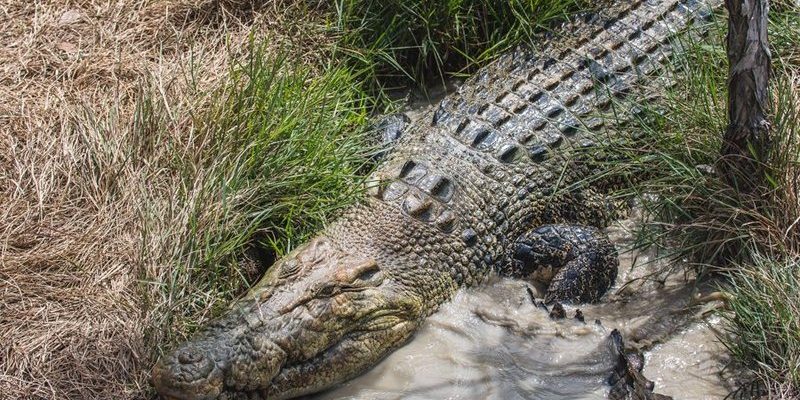
Understanding Their Habitat
Let’s start with where you might find these incredible creatures. Saltwater crocodiles are often found in tropical and subtropical regions. You can see them lounging in estuaries, rivers, and sometimes even in the open ocean. They prefer areas with brackish water, which is a mix of fresh and saltwater.
When you approach a potential crocodile habitat, look for certain features that can indicate their presence. Salties love:
- Shallow coastal waters
- Swamps and mangrove forests
- Rivers and lakes with direct access to the sea
If you spot these environments, you might be in crocodile territory! Just remember: being aware of your surroundings is key to staying safe.
Size and Coloration: The Basics
One of the first traits to notice is their size. Saltwater crocodiles can grow to be massive, with some reaching lengths of up to 23 feet! That’s about the size of a small school bus! They can weigh over a ton, so if you see something big and floating, it’s worth a second look.
Their coloration is another telltale sign. These crocodiles are typically a mix of green, gray, and brown, helping them blend into their surroundings. The color often darkens with age. As you scan the water, look for their rough, scaly back and the characteristic crocodilian shape—the long snout and powerful tail. If you see something large with these features, you might be looking at a saltwater crocodile.
Identifying Their Snout and Teeth
When it comes to saltwater crocodiles, their snout is a distinctive feature. They have a long, narrow head, which is quite different from the broader snouts of other crocodilian species. This shape allows them to catch fish and other prey easily.
Another cool thing to note is their teeth. Salties have 64 to 68 teeth in total, and they’re designed for gripping rather than chewing. When their jaws are closed, you’ll often see some of the upper teeth fit into notches in their lower jaw. If you catch a glimpse of their jaws while they’re basking, this unique tooth alignment is a sure sign you’re looking at a saltwater crocodile!
Behavioral Traits to Watch For
Behavior can also give clues about whether you’ve spotted a saltwater crocodile. These reptiles are known for their patience. They can sit motionless for hours, waiting for prey to come close. If you see something hovering still in the water, it could very well be a crocodile waiting for the perfect moment to strike.
More decisive behavior includes their ability to swim surprisingly fast. If you see a quick splash or movement in the water, it could be a crocodile making a swift retreat or approach. Also, they’re often seen basking on riverbanks or beaches, soaking up the sun. If you’re walking along a shore, keep an eye out for a large creature lounging in the sun—this could be a saltwater crocodile catching some rays.
Understanding Their Tracks and Signs
If you’re hiking near water and want to confirm the presence of a saltwater crocodile, look for tracks or other signs. Salties leave distinctive footprints that can be about a foot in length. They often feature webbed toes and a long, dragging tail mark in the mud.
Additionally, you might notice areas where they’ve been basking. Look for flattened patches of vegetation near water’s edge—this could indicate a favorite sunning spot. You might also see remains of their prey, like fish or birds, lying nearby. Spotting these signs can help you understand their habits and territory.
Safety Precautions While Observing
Now that you know how to identify a saltwater crocodile, it’s essential to consider safety. These animals are powerful and can be unpredictable. If you plan to explore their habitats, here are some important safety tips:
- Keep a safe distance—stay at least 20 feet away from the water’s edge.
- Don’t feed or provoke them; this can lead to dangerous situations.
- Travel in groups and make noise to avoid startling them.
Always be aware of signs indicating crocodile presence, like warning signs at beaches or rivers. If you feel unsure, it’s best to err on the side of caution and steer clear of that area.
When to Seek Expert Help
Sometimes, you might encounter a saltwater crocodile under unusual circumstances—like if one wanders into a populated area. If you see a crocodile in an unexpected place, it’s essential to contact local wildlife authorities. Experts can handle the situation safely and humanely and ensure that both the community and the crocodile stay protected.
You might wonder why it’s vital to let professionals handle these situations. Well, while saltwater crocodiles are fascinating, they can also pose serious risks. Experts have the training to deal with wildlife effectively, ensuring everyone’s safety.
Identifying a saltwater crocodile in the wild can be an exhilarating experience. With their impressive size, distinctive features, and fascinating behavior, they truly are the kings of their domain. However, always keep safety as your top priority. By understanding their habitat, spotting key physical traits, and knowing how to react in their presence, you can enjoy the adventure of wildlife observation while staying safe.
So, the next time you’re exploring near water, keep an eye out for the powerful saltwater crocodile. With these tips in mind, you’ll be well-equipped to spot one while respecting their space. Happy exploring!

